Table of Contents Show
On November 12th, a day after Taylor Swift’s release of “Red” (Taylor’s Version), the world had no moment to dry their eyes as the short film for “All Too Well” dropped. For those who have been living under a rock, this re-release of her 2012 album is part of Swift’s extensive project of re-recording her albums, gaining back control of her masters. (That whole story is a different article entirely.) However, before getting into the short film, the myth behind the ten-minute “All Too Well” must be discussed. This song is something akin to a legend for swifties. As the story goes, the original version of “All Too Well” was over ten minutes long. Back in the day, the most circulated story was from co-writer Liz Rose who said that there was no physical copy of this fabled song besides the version of it in Swift’s head. Taylor,
“Had this list of things she wanted to put in it. It was probably a twenty-minute song when she called me. And she knew I could help her whittle it down and work on the brillant pieces of it.”
(( Skinner, Paige. “From Irving to Nashville to a Grammy: Songwriter Liz Rose Crushes It.” Dallas Observer, 6 Feb, 2019. ))
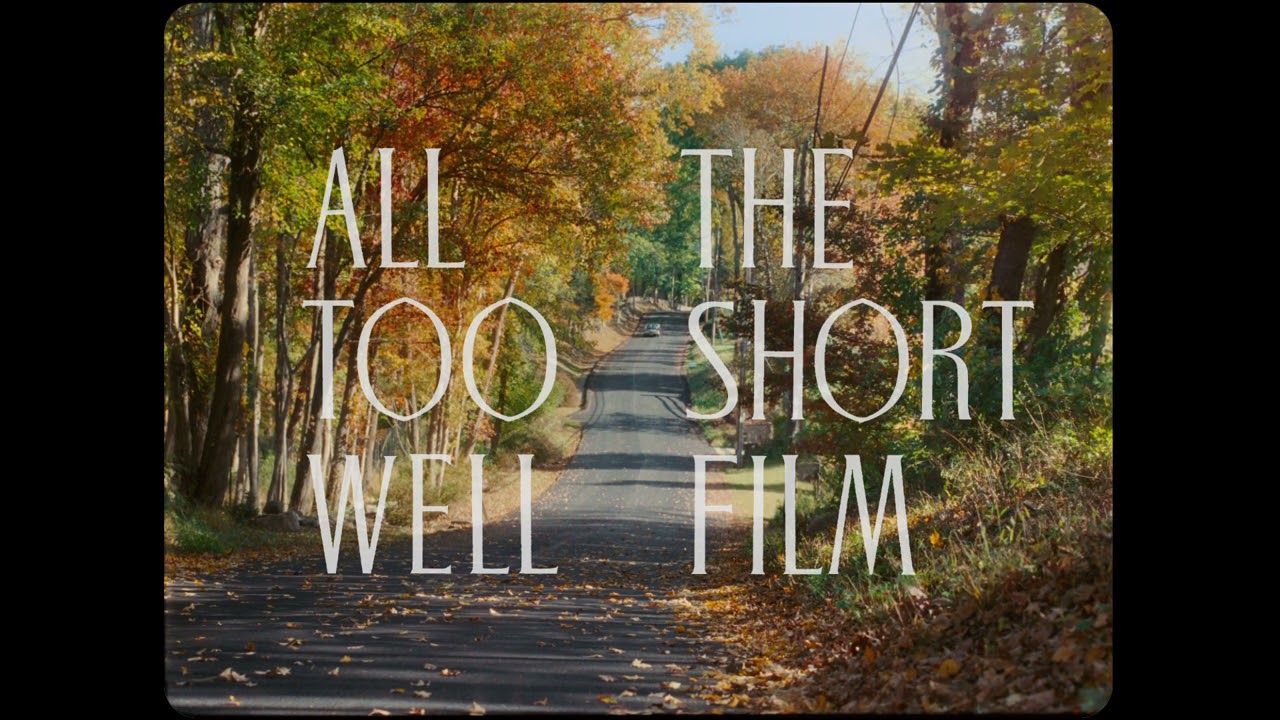
To say fans were shocked to hear that they would be receiving this version of the song would be an understatement. The immediate fan favorite of the album, “All Too Well,” is widely regarded as the songwriter’s best work to date. Moreover, the song’s poignant storytelling showcases Swift’s arguably greatest asset — her ability to be both deeply specific and vastly accessible — something the short film highlights even further.
This Slope Is Treacherous: An Aesthetic Analysis
The aesthetic choices made in All Too Well: The Short Film elevates Swift’s storytelling and showcases her proclivity towards an authentic vulnerability that fans continue to champion. Written and directed by Swift, the film is divided into sections with accompanying titles depicting differing stages of the relationship between Sadie Sink and Dylan O’Brien. Playing the role of “Him,” O’Brien captures the charismatic arrogance of Jake Gyllenhaal. In contrast, Sink, playing the role of “Her,” encapsulates the “wide-eyed gaze” (( Taylor Swift. “All Too Well (10 Minute Version) (Taylor’s Version) (From the Vault).” Red (Taylor’s Version), Republic Records, 2021. Spotify. )) of young Swift. From golden hour memories to chilling lonesome blues, the film evokes a visceral response that places the viewer right into the turbulence of the relationship.
Before We Hit Play
It is important to note the age difference between Sink and O’Brien. Nineteen and thirty, respectively, this age gap is a deliberate action made to highlight the actual age gap Swift experienced in her relationship with Gyllenhaal. Choosing to cast Sink was a salient move as she is well-known for her role-playing a kid in the Netflix series Stranger Things. Many viewers grew up alongside her and still see her as a child. O’Brien is also a well-known figure. Even if one does not know his exact age, it is clear he is significantly older than baby-faced Sink. This visual contrast is a quick way to showcase the power imbalance between the couple and signals the recurring issue of maturity that permeates the relationship, even before hitting play.
The Epigraph
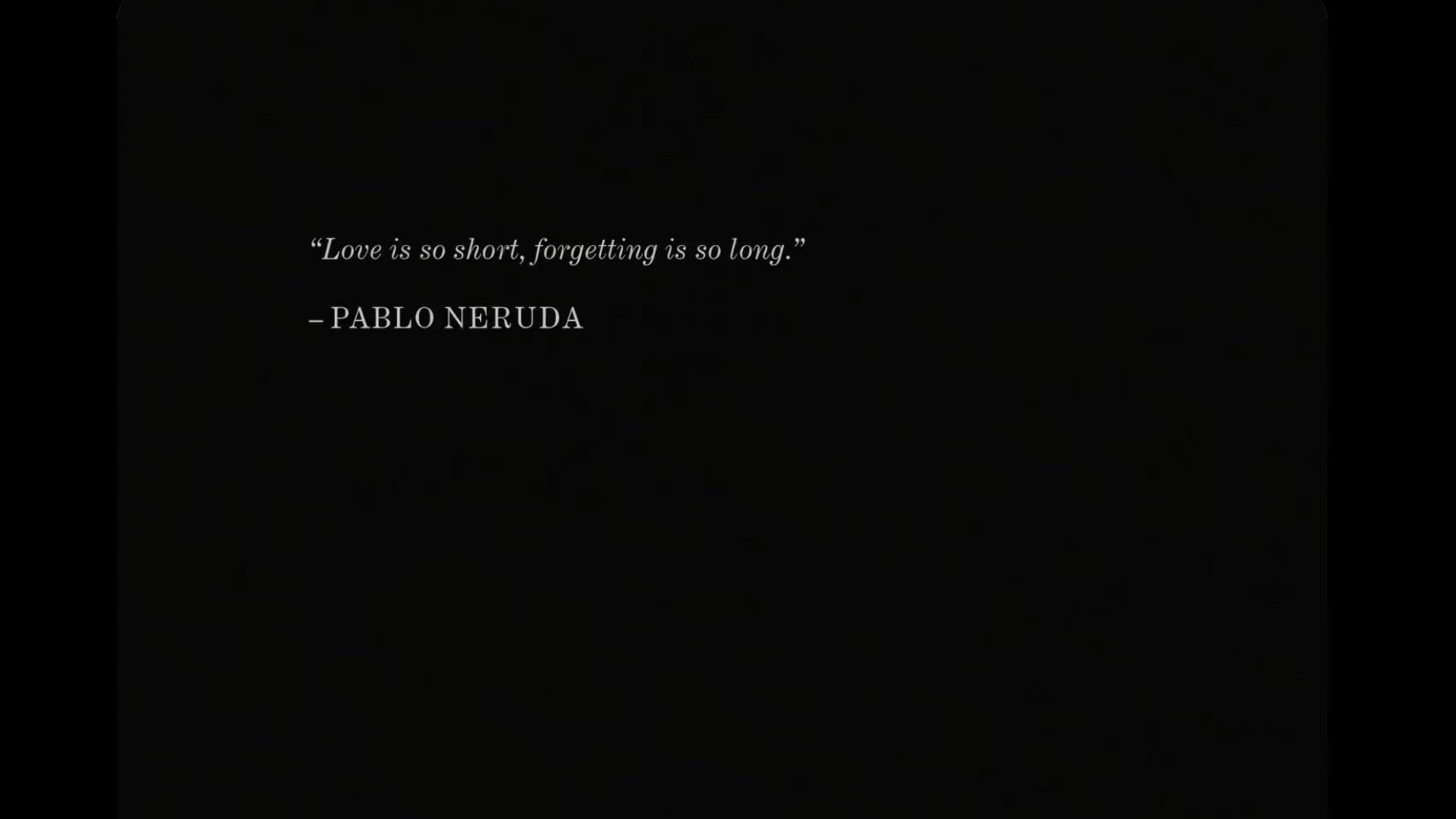
After hitting play, the first visual a viewer is greeted with is a quote from poet Pablo Neruda reading, “Love is so short, forgetting is so long.” Instantly recalling films such as Lady Bird (2017; Great Gerwig) and The Breakfast Club (1985; John Hughes), this epigraph serves as a mission statement for the film and “Red” (Taylor’s Version) as an album. Swift originally quoted this line in her prologue for “Red” (2012), saying,
“It’s a line I’ve related to in my saddest moments, when I needed to know someone else had felt that exact same way. And when we’re trying to move on the moments we always go back to aren’t the mundane ones. They are the moments you saw sparks that weren’t really there, felt stars aligning without having any proof, saw your future before it happened, and then saw it slip away without any warning.”
(( Taylor Swift. “Prologue.” Red, Big Machine Records. 2012. )).
The Opening Shot
Opening shots are crucial to a story. They are the veiwer’s initial entry into a world, a first impression of what is to come. Basked in the morning light and entangled in one another, the viewer sets their eyes on the ill-fated All Too Well couple for the first time. An overhead shot, they lie together, reflections of themselves. In a whisper, the young woman asks, “Are you for real?…I just feel like maybe I made you up.” (( All Too Well: The Short Film. Directed by Taylor Swift, performances by Sadie Sink and Dylan O’Brien, PolyGram Entertainment, Republic Records, Universal Pictures, 2021. ))
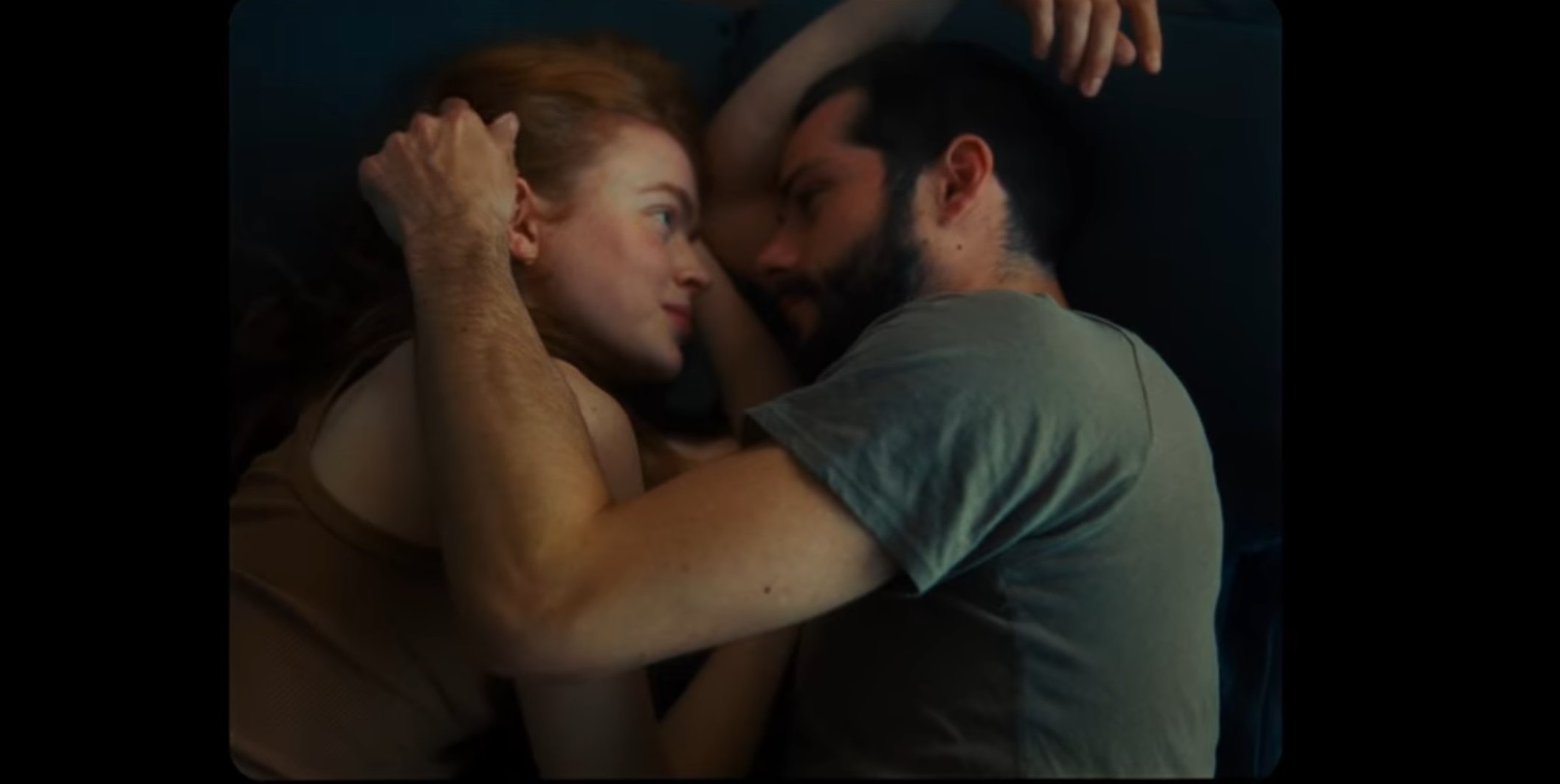
Shot on 35mm film by cinematographer Rina Yang, this aesthetic choice, in tandem with a 4:3 aspect ratio, produces a nostalgic image that is far more constrained than the average viewer is used to. In this way, the viewer enters into the intimacy of the relationship through this confined space, invited into this slice of vulnerability. But, having just read the epigraph, it is obvious the couple will not last. This wistful moment is, at its heart, what the song “All Too Well” is about. It is a reflection, looking back on a relationship — not just the bad, but the euphoric happiness, those slices of good that proves it was something — all of it. It happened. It hurt. It was real.
The Kiss
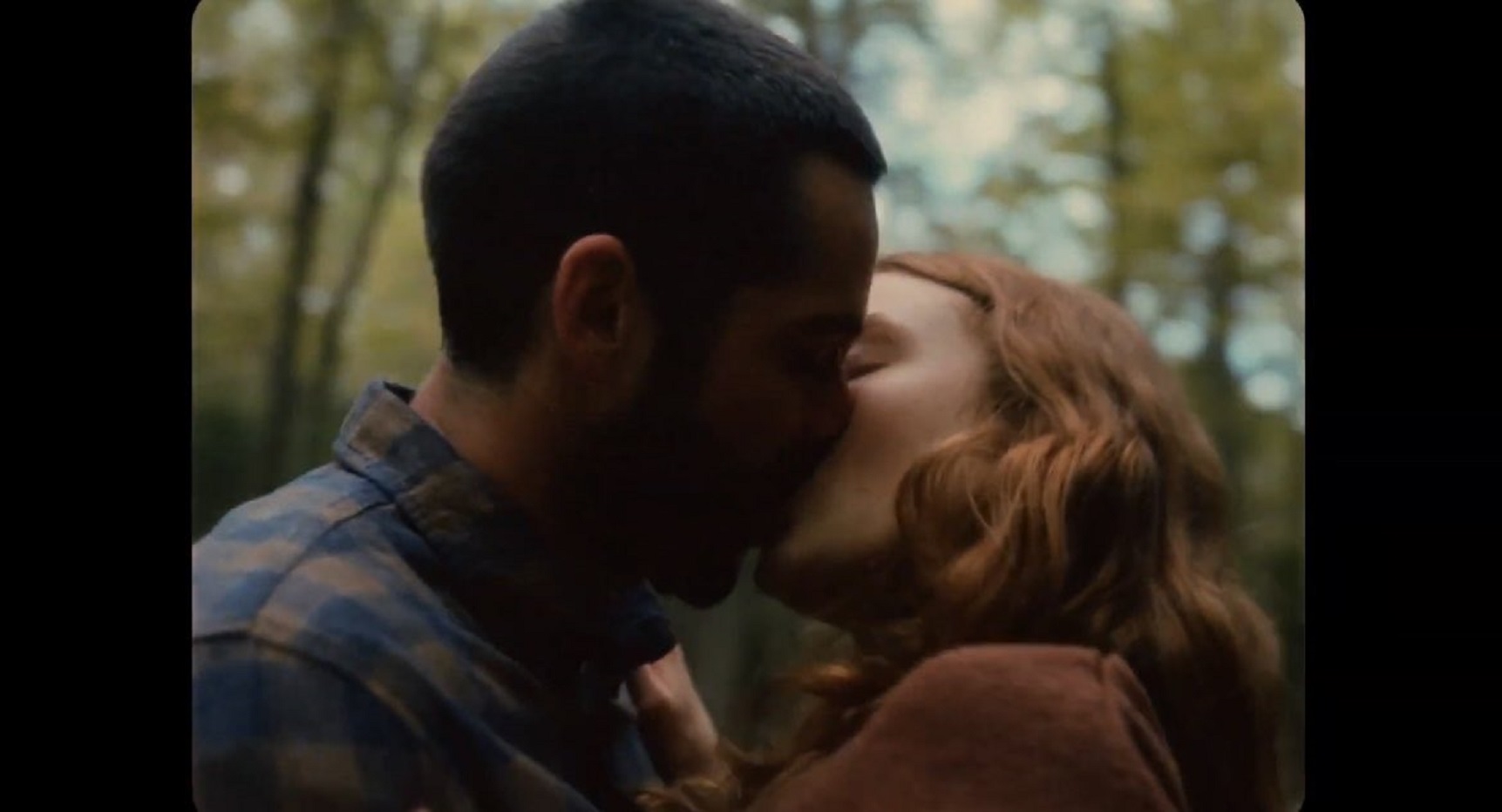
The first kiss shared between “Him” and “Her” comes with a bittersweet tang. The shot is set up beautifully as the camera spins 360 degrees around the couple. This is a cliché often referred to as an “orbital kiss” (( TV Tropes Contributors. “Orbital Kiss.” TV Tropes. 2021. )) — a romantic trope used to showcase joy so momentous even the camera could not sit still. Surrounded by the vibrant beauty of autumn, the shot is head-over-heels, absolute fairytale bliss. Yet, as romantic of a setup up the moment is, it is tainted by the discomfort of watching Sink and O’Brien locking lips. This is intentional to understanding the narrative, a purposeful discomfort. These fleeting moments of fairytale happiness make the inevitable heartbreak all the more harrowing.
The Kitchen Argument
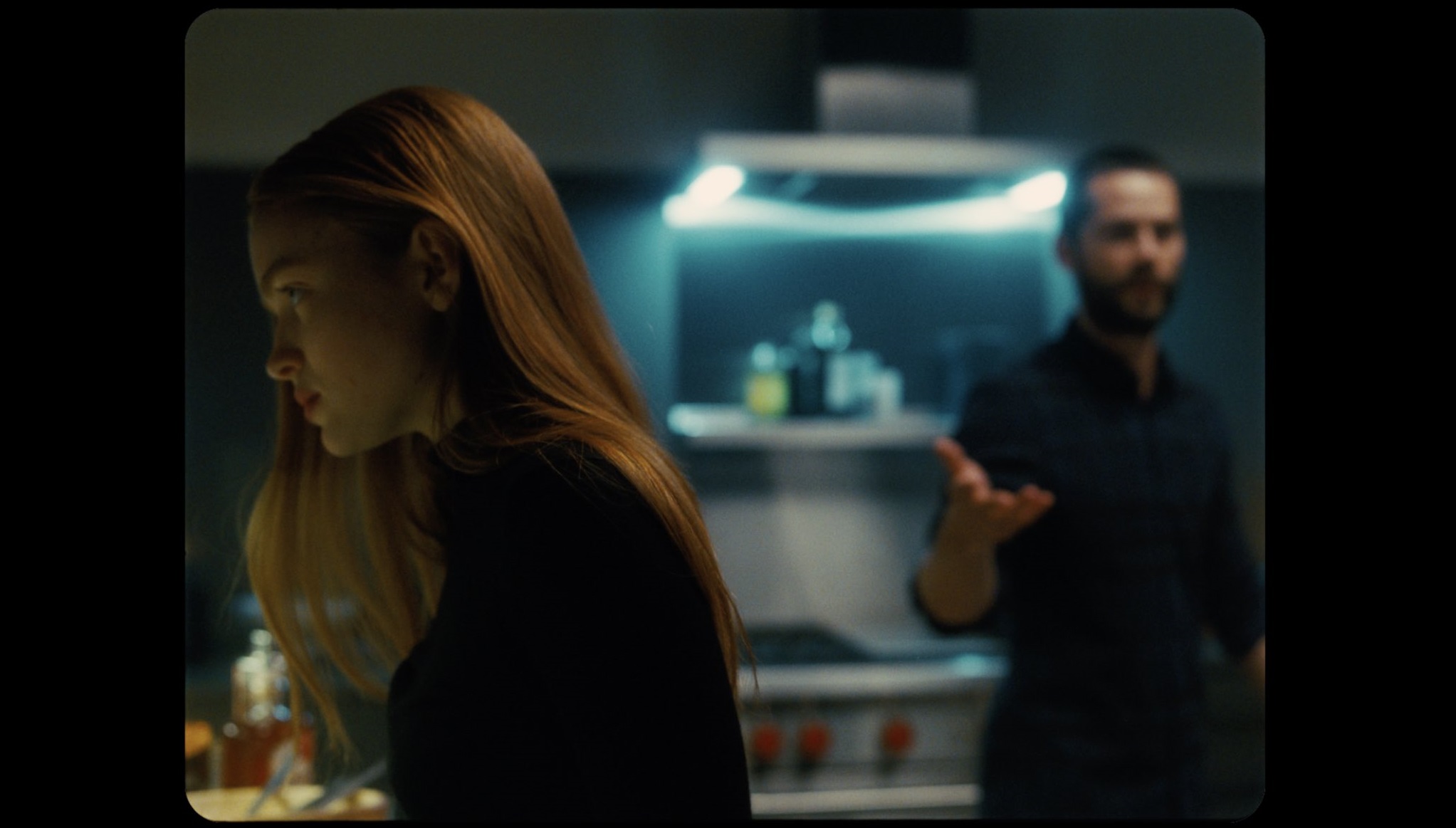
Here is where the story turns from fairytale to tragedy. After a dinner party with friends, all “His” friends, Sink’s character is hurt from having her hand dropped by her partner at the table. Repositioned by “Him” with a condescending pat, this moment is jarring as the lead up to it has solely shown hands in moments of intimacy, intertwined and gentle. This is a moment that disrupts the fairytale. If it was not abundantly clear, there is also a dramatic change in lighting as the short film switches from warm light to harsh, artificial blues — golden hour is over.
The Breakdown
Sink’s performance throughout the entire short film is remarkable, but the breakdown sequence is particularly astounding. Now alone, she lays in bed, sobbing as her phone lights up with a call. With a shaky, panicked gasp, she silences the ringer. Once again, in an aerial shot, Sink is shown in bed. This time she is alone — a direct contrast to the opening scene — but this time, all she is tangled up in is her own comforter. As Sink sits in her messy room, numb and staring into nothing, Swift sings, “Time won’t fly, it’s like I’m paralyzed by it. I’d like to be my old self again, but I’m still tryin’ to find it.” (( Taylor Swift. “All Too Well (10 Minute Version) (Taylor’s Version) (From the Vault).” Red (Taylor’s Version), Republic Records, 2021. Spotify. ))
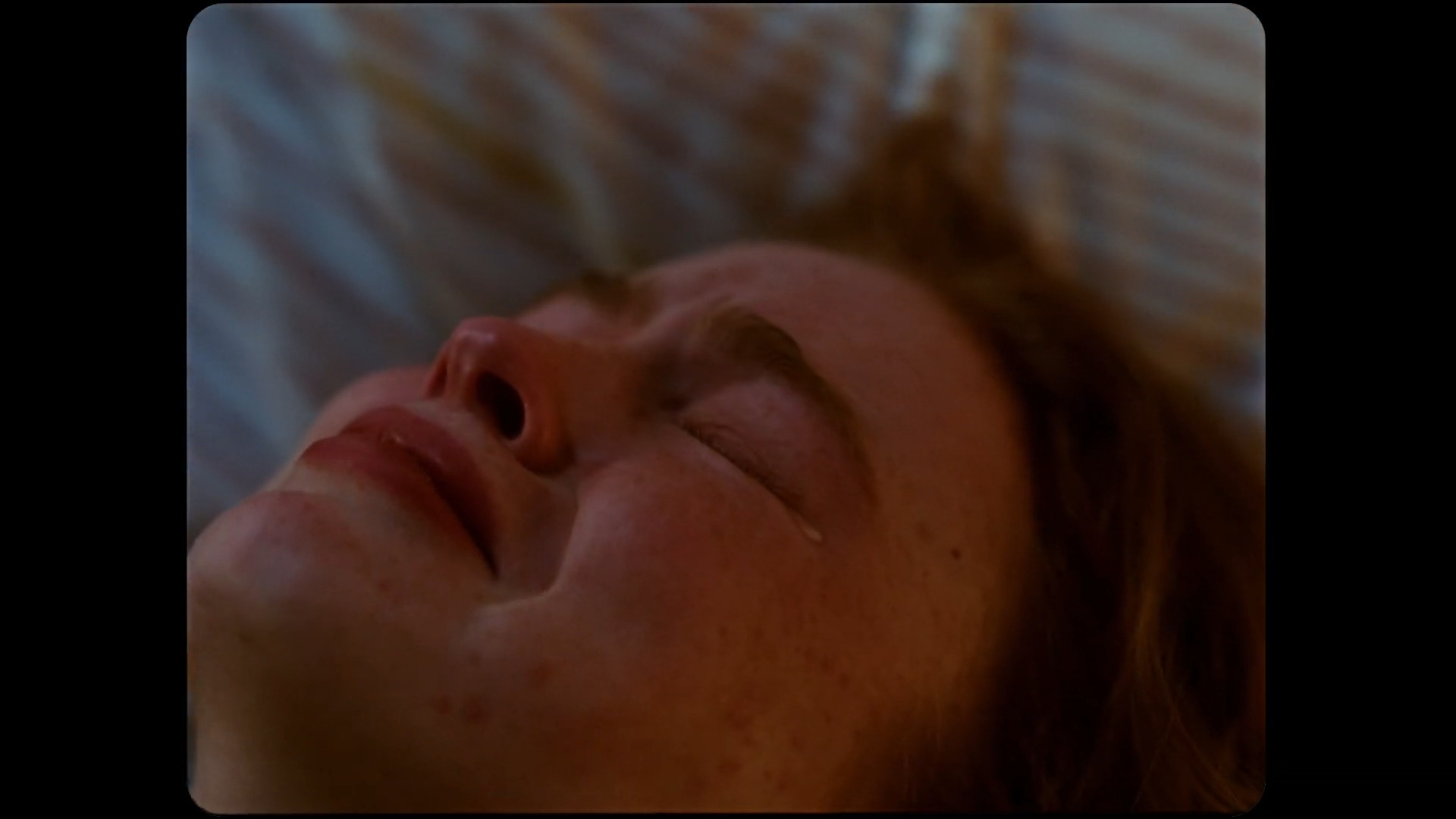
This is followed by the image above, a close-up of Sink’s face as she scrunches her eyes closed, tears spilling out the side. She is taking up the majority of the frame, just as her emotions, her sadness, are taking up most of her life. This use of a close-up draws the viewer into the action, placing them in the room right alongside Sink. Her red nose and flushed face serve as a painful reminder to the theme that Swift is accentuating — loving “Him” was red.
The Closing Shot
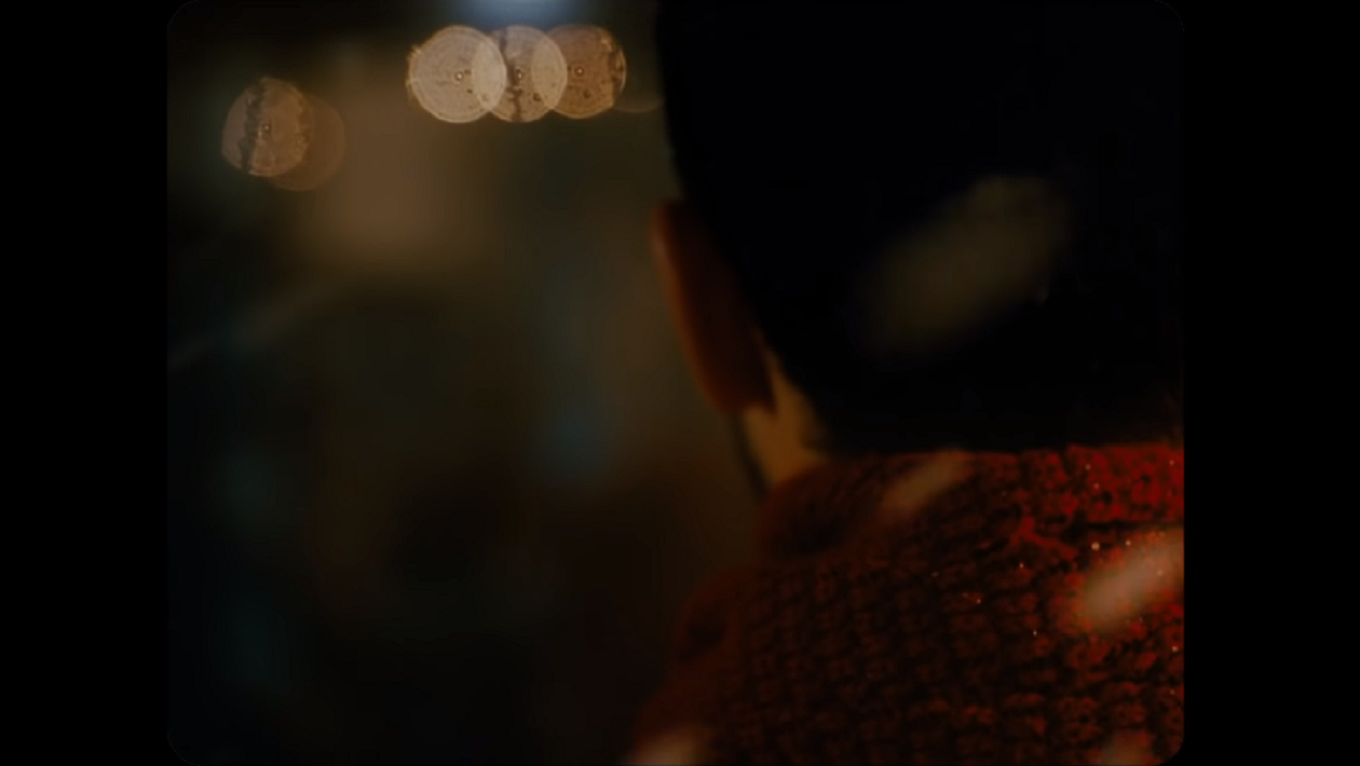
Just as important as the opening shot, the closing shot is the last impression one leaves with their viewers. Now, the actress of “Her” has been swapped from Sink to Swift as the viewer finds out thirteen years have come and gone. In the very last moments of All Too Well, O’Brien stands out in the cold, the red scarf wrapped around his neck. He looks into a bookstore as his old lover, now a widely successful author reads to an audience. Only the back of his head is shown, a sign that he is no longer important to the narrative of “Her” life; she has reclaimed it. Additionally, there is a physical barrier of the windowpane separating the two. Once again, a direct contrast to the opening scene where they were wrapped in each other’s limbs. Always a contrasting parallel of one another; it is cold and flurrying outside, while warm and cozy inside. After a moment, he walks out of the frame entirely, leaving only the blurring imagery of falling, glistening snow in his wake.
In Burning Red: Themes
A few motifs are running throughout All Too Well that demand special attention. The color red, the scarf, and the use of hands are three ways Swift tells such a compelling story in just fourteen minutes.
The Color Red
Beautifully complemented in the film, the motif of the color red is a prevailing theme throughout the song. A reason why so many attest “All Too Well” as Swift’s best work, the lyrics are cinematic, making it a successful transition to the screen. Sink’s vibrant red hair adds to this symbolic representation of red as an emotion, whether intentional or not. In contrast, O’Brien is consistently shown in dark, calm tones, often bathed in hues of blue.
The Scarf
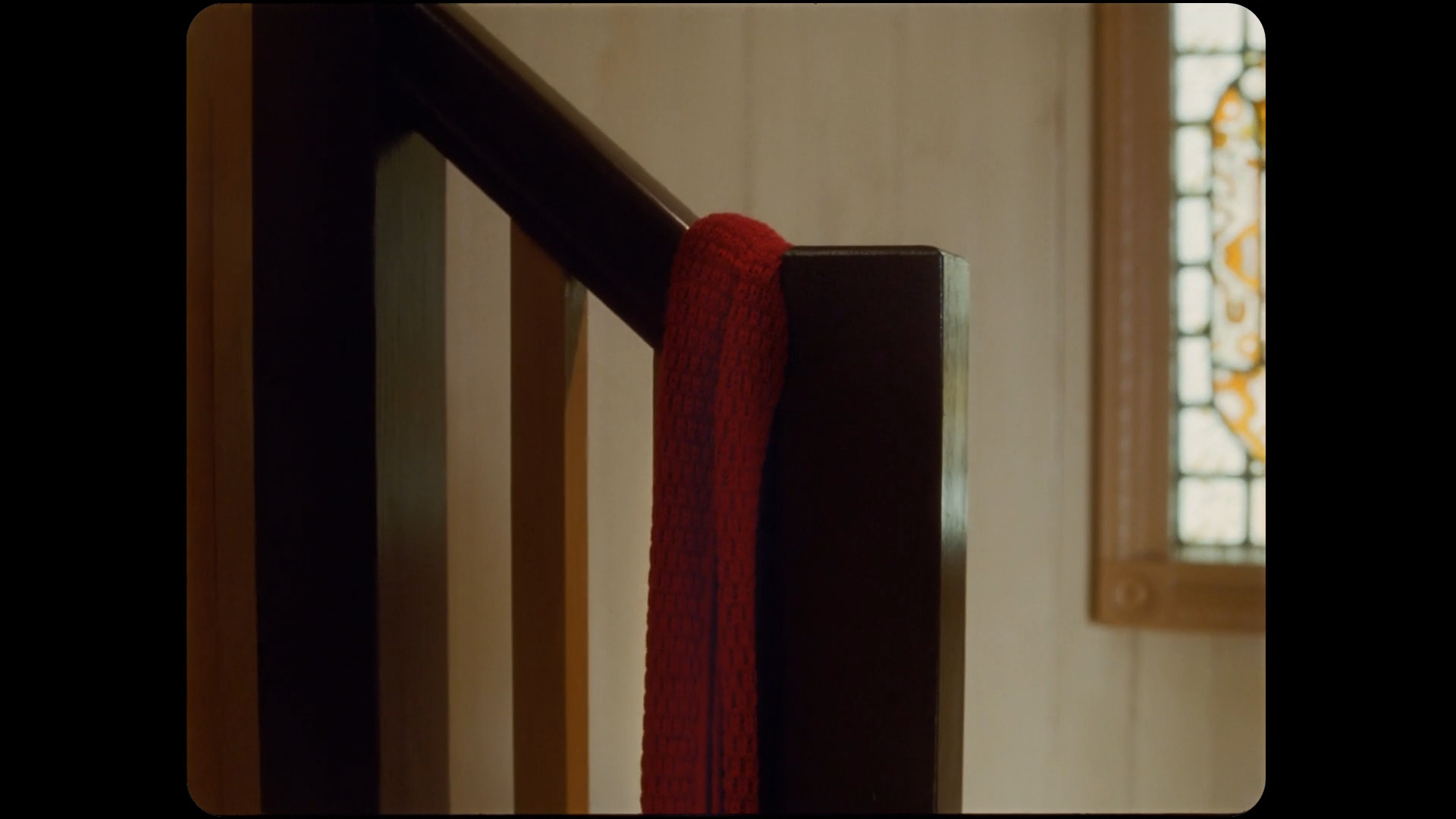
The red scarf has become a symbol for “Red” as an album — something particularly amusing considering the original scarf was navy with silver and maroon stripes. More important than the specific color of the scarf, however, is what the scarf represents. That is to say, a symbol of innocence: “But you keep my old scarf from that very first week. ‘Cause it reminds you of innocence and it smells like me.” (( Taylor Swift. “All Too Well (10 Minute Version) (Taylor’s Version) (From the Vault).” Red (Taylor’s Version), Republic Records, 2021. Spotify. )) Although she unintentionally left her scarf at his sister’s house, she has given him a piece of her. Something Swift implies that lingers with him to this day.
Hands
Throughout All Too Well, there is an emphasis placed on capturing hands. They remain significant in every scene, continually foregrounded in the unfolding narrative. Written and directed by Swift, she places importance on touch as a love language, shown directly through the use of hands. This intensity placed on the hands, and thus touch, can be prescribed to the employment of the “female gaze.” The “female gaze” is a term created in response to the “male gaze.” Feminist film scholar Luara Mulvery coined the term “male gaze” to describe the vouersytic gaze woman fall to the receiving end of. In contrast to the passive “male gaze” where women are looked at, the “female gaze” is active, giving agency to women as subjects who can still be looked at but have the ability to look back.
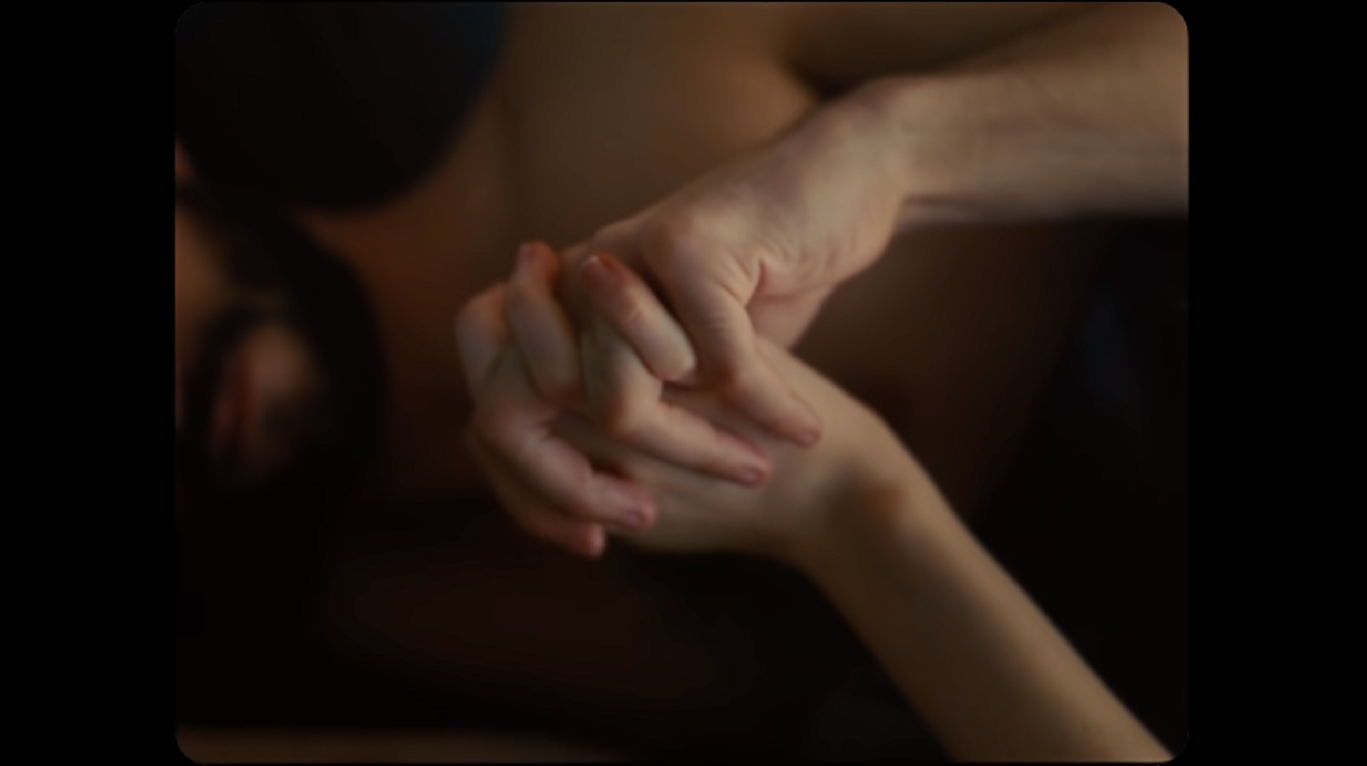
Hands signal a middle-ground. To touch, to be touched is a push and pull. Both characters have agency here, just as a healthy relationship should. This also works to indicate vulnerability. When O’Brien’s character is trying to persuade Sink’s to forgive him, he holds her face in his hands. She clings to his jacket by the lake. They fit their fingers in the spaces between each other’s while they lie in bed. Hands are continuously prioritized throughout All Too Well to show additional emotional responses. This makes juxtapositions like the dinner party and Sink mourning the end of the relationship alone in her room without touch from even a friend, all the more affecting.
Another Success Story For Miss Swift
Creating a ten-minute song is an endeavor in itself. Turning a ten-minute song into a short film is something else entirely. It seems as if Swift’s success knows no bounds as both critics and fans have widely celebrated each. An aesthetic triumph and reclamation of her past, All Too Well: The Short Film is but another career-defining moment for Miss Swift.

Thank you for this thoughtful and detailed analysis of the aesthetics of All Too Well: The Short Film. I have a question about a certain aesthetic choice in the film that has been puzzling me for a while–I’m very curious to know your thoughts on it. I’m referring to the aesthetic choice that was made by Taylor Swift to have Sadie Sink’s character wear an orangish-brown tank top in all of the kissing/bedroom scenes in the film. This stylistic choice is odd to me, because, as you point out in your analysis, the opening shot of the couple lying in bed together is a crucial first look at the intense intimacy of their doomed romance, so I’m very confused as to why Taylor Swift made the choice to have Sadie Sink’s character wear an orangish brown tank top in this scene (as is evident in your screenshot of the opening scene, Dylan O’Brien’s character is also clothed, in a grayish-blue T-shirt). I’m just wondering if it would have been a more realistic depiction of intimacy to have the characters not be clothed while lying in bed together? I’m not saying there should have been explicit nudity in the film; I’m just wondering if there could have been a way to imply the characters’ nakedness without actually showing anything explicit. But I could be wrong about Sadie wearing the brown tank top in every bedroom scene. I took a screenshot of a moment from one of the bedroom scenes…could you please take a look at the screenshot I took and tell me whether or not it looks to you like Sadie Sink’s character is wearing a top? I’m attaching the photo below…I can’t tell if what I’m looking at in the photo is a tank top or just her long hair. Could you please tell me what you think? Thank you for reading all this.